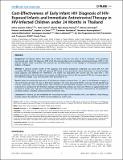Cost-Effectiveness of Early Infant HIV Diagnosis of HIV-Exposed Infants and Immediate Antiretroviral Therapy in HIV-Infected Children under 24 Months in Thailand

View/
Author
Collins, Intira Jeannie
Cairns, John
Ngo-Giang-Huong, Nicole
Sirirungsi, Wasna
Leechanachai, Pranee
Le Coeur, Sophie
Samleerat, Tanawan
Kamonpakorn, Nareerat
Mekmullica, Jutarat
Note: Order does not necessarily reflect citation order of authors.
Published Version
https://doi.org/10.1371/journal.pone.0091004Metadata
Show full item recordCitation
Collins, I. J., J. Cairns, N. Ngo-Giang-Huong, W. Sirirungsi, P. Leechanachai, S. Le Coeur, T. Samleerat, et al. 2014. “Cost-Effectiveness of Early Infant HIV Diagnosis of HIV-Exposed Infants and Immediate Antiretroviral Therapy in HIV-Infected Children under 24 Months in Thailand.” PLoS ONE 9 (3): e91004. doi:10.1371/journal.pone.0091004. http://dx.doi.org/10.1371/journal.pone.0091004.Abstract
Background: HIV-infected infants have high risk of death in the first two years of life if untreated. WHO guidelines recommend early infant HIV diagnosis (EID) of all HIV-exposed infants and immediate antiretroviral therapy (ART) in HIV-infected children under 24-months. We assessed the cost-effectiveness of this strategy in HIV-exposed non-breastfed children in Thailand. Methods: A decision analytic model of HIV diagnosis and disease progression compared: EID using DNA PCR with immediate ART (Early-Early); or EID with deferred ART based on immune/clinical criteria (Early-Late); vs. clinical/serology based diagnosis and deferred ART (Reference). The model was populated with survival and cost data from a Thai observational cohort and the literature. Incremental cost-effectiveness ratio per life-year gained (LYG) was compared against the Reference strategy. Costs and outcomes were discounted at 3%. Results: Mean discounted life expectancy of HIV-infected children increased from 13.3 years in the Reference strategy to 14.3 in the Early-Late and 17.8 years in Early-Early strategies. The mean discounted lifetime cost was $17,335, $22,583 and $29,108, respectively. The cost-effectiveness ratio of Early-Late and Early-Early strategies was $5,149 and $2,615 per LYG, respectively as compared to the Reference strategy. The Early-Early strategy was most cost-effective at approximately half the domestic product per capita per LYG ($4,420 in Thailand 2011). The results were robust in deterministic and probabilistic sensitivity analyses including varying perinatal transmission rates. Conclusion: In Thailand, EID and immediate ART would lead to major survival benefits and is cost- effective. These findings strongly support the adoption of WHO recommendations as routine care.Other Sources
http://www.ncbi.nlm.nih.gov/pmc/articles/PMC3954590/pdf/Terms of Use
This article is made available under the terms and conditions applicable to Other Posted Material, as set forth at http://nrs.harvard.edu/urn-3:HUL.InstRepos:dash.current.terms-of-use#LAACitable link to this page
http://nrs.harvard.edu/urn-3:HUL.InstRepos:12064401
Collections
- SPH Scholarly Articles [6362]
Contact administrator regarding this item (to report mistakes or request changes)


